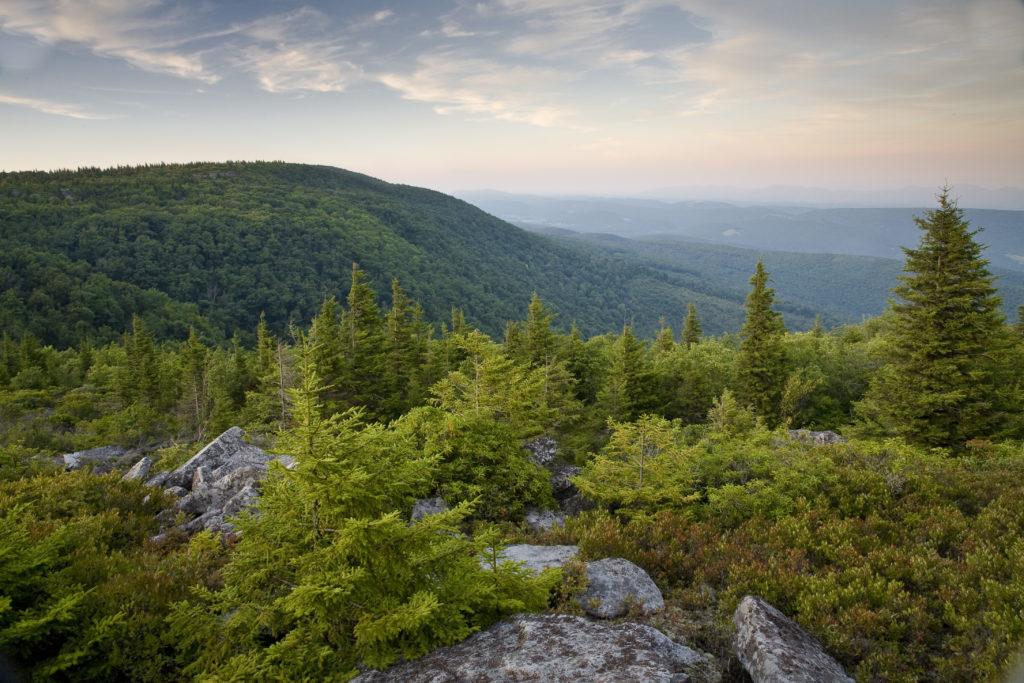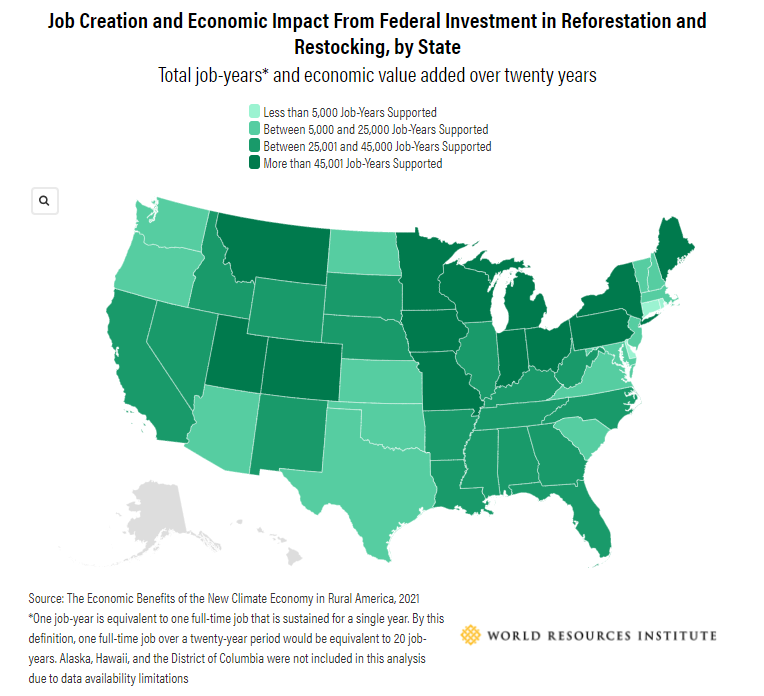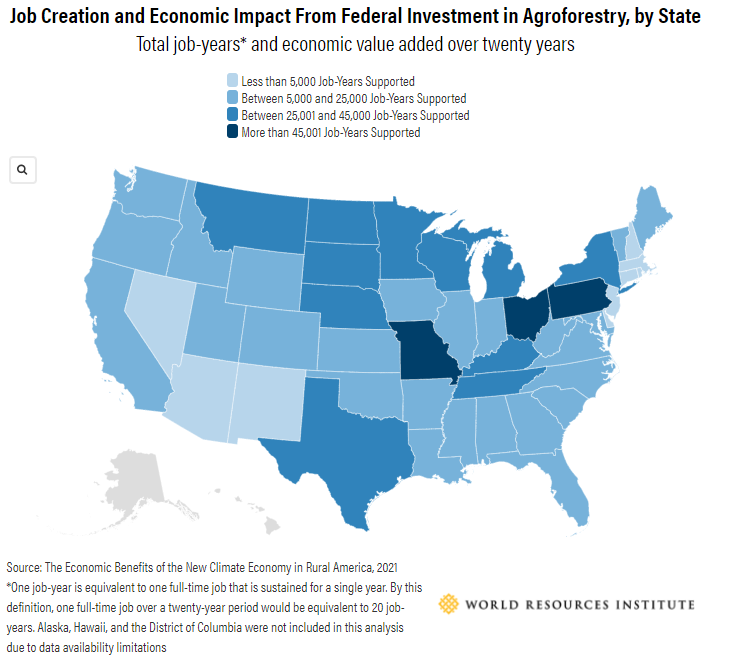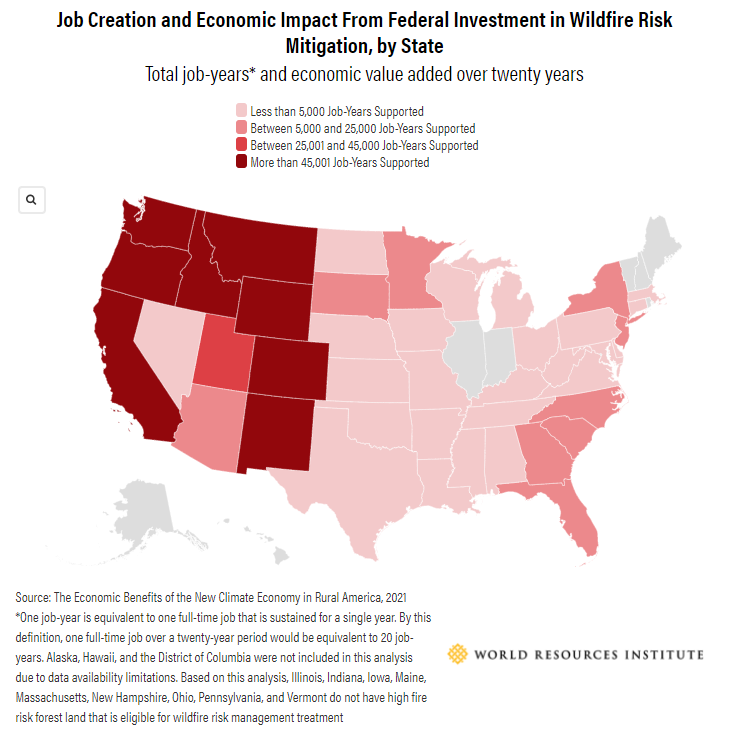Last updated on February 8th, 2024
This article includes excerpts from a longer article published by World Resources Institute. Read the original article here.

To reach the United States’ target of reducing net emissions by 50-52% from 2005 levels by 2030, the federal government and non-federal actors will need to increase the ability of natural and working lands to sequester and store carbon. A recent economy-wide analysis finds that reaching these climate goals will require the United States to enable its lands and forests, or its land carbon sink, to remove at least 913 Mt CO2e annually by 2030, which represents a 13% increase in yearly sequestration over 2019 levels. This increase in sequestration would be equal to the emissions from over 20 million cars every year.
To achieve this, the nation must restore trees to the landscape, increase the adoption of climate-smart agricultural practices and protect landscapes that already store carbon. Federal investment and action from all levels of society can allow the United States to achieve the full potential of these pathways, creating jobs and other economic benefits in the process.
Seizing the United States’ Most Promising Natural Climate Solutions
While action is needed across all land sectors, research shows that three tree-based pathways hold the greatest opportunity for enhancing natural carbon removal in the near-term while supporting jobs and economic vitality. WRI analysis shows that these pathways could offer an attractive return on investment: they require a total federal investment of $126.6 billion over 20 years and would support approximately 3.9 million job-years (or 199,000 jobs each year for 20 years). Put another way, 31.4 jobs would be supported for every million dollars of federal investment. Over 20 years, this investment would also generate $226.8 billion in value added to local economies, including $164.4 billion in employee compensation and $12.2 billion in state, federal and local taxes.
Table 1: Economic Impact of Natural Climate Mitigation Pathways

1. Reforesting and Restocking Trees
Trees are a carbon-removing technology that is ready for deployment today. Although building the infrastructure to plant healthy forests at the necessary scale will require considerable investment and work, there are already professionals working to plant and manage trees and forests every day. Federal investment in reforestation and forest restocking could help to expand employment in these sectors, particularly in rural areas, where 67% of job creation potential exists.
Across federal, state, local and private lands, there is an opportunity to reforest historically forested land that has been cleared, disrupted or burned and has lost the ability to sequester carbon. There is also an opportunity to restock, or increase the density of, existing forests in the eastern and midwestern United States where trees have been lost due to disease or disruption, and where increased forested density would not increase fire risk.
Non-federal lands, which include state, local and private lands, hold the greatest potential for carbon removal and job creation. In these lands, 185.4 million acres are eligible for reforestation and restocking. This could remove 156 MtCO2e per year by 2030, and up to 312 MtCO2e per year in 2040 and beyond. Reforestation and restocking on non-federal land could also support 68,100 jobs across multiple sectors annually.
Federal lands offer an additional 18 million acres suitable for reforestation and restocking. Collectively, these lands could sequester an additional 17 MtCO2e per year by 2030 and up to 35 MtCO2e per year in 2040 and beyond. Investment in reforestation and restocking on federal land could support 11,700 jobs annually.
Across both federal and non-federal lands, an annual federal investment of $3 billion per year for 20 years could support 79,800 jobs annually, or 26.8 jobs per one million dollars of investment. Missouri, Ohio, Michigan, Pennsylvania and Wisconsin would see the highest total levels of job creation from reforestation and restocking across all land ownership types.

2. Agroforestry
Agroforestry, or the practice of incorporating trees into agricultural systems, could help expand trees and their climate benefits. This would also benefit farmers and ranchers, as agroforestry can improve soil, crop and animal health, and provide added revenue from forest products and timber. Agroforestry practices with notable climate benefits include silvopasture, or integrating trees into animal agriculture; alley cropping, or interspersing row crops with rows of trees; and planting windbreaks, or strategically placed groups of shrubs and trees that prevent soil erosion and protect crops and livestock. There are approximately 110.9 million acres of U.S. cropland and pastureland that may be eligible for agroforestry and could sequester 156 MMT CO2e per year.
Establishing and maintaining agroforestry systems can be labor-intensive and require specialized expertise, which can further support jobs. However, agroforestry systems can be expensive to establish, which can pose a barrier for farmers. Federal investment can help landowners establish agroforestry systems and support jobs in the process. An annual federal investment of $1.8 billion in agroforestry could support 49,500 jobs annually, or 27.4 jobs per million dollars invested, and provide other economic benefits. Missouri, Ohio, Pennsylvania, South Dakota and Texas would see the highest total levels of job creation from expansion of agroforestry.

3. Wildfire Risk Mitigation
Many forests in the United States, particularly in Western states, are at high risk for severe fire due to widespread tree death from drought, disease and historical fire suppression. Severe fires threaten forest-adjacent communities and permanently damage trees and ecosystems, which can turn forests into a source of emissions. Wildfires also produce pollutants that can increase the risk of respiratory and cardiovascular health problems in people who inhale smoke.
Techniques to reduce severe wildfire risk include removing biomass, strategically thinning out overly dense forests and conducting controlled, low-intensity burns to remove fuels that could feed severe blazes. These kinds of treatments — known as fuel load treatments — do not prevent wildfire from occurring, but they lower the risk of massive fires. Prescribed burning alone could reduce wildfire carbon emissions in the western United States by 18–25% and could increase long-term forest carbon storage by 18 MtCO2 per year through avoided tree mortality.
The increasing frequency of catastrophic wildfires across the United States highlights the importance of ambitious and immediate investment to increase ecosystem health and reduce the risk of severe wildfire. There are over 86.7 million acres of forest in the nation that could be eligible for fuel load treatments. Federal investment could help mitigate the risk of wildfire in these forests and would directly employ prescribed burn professionals and forestry professionals. Fuel load treatment also generates biomass and timber that can have downstream uses that generate employment.
Accounting for both fuel load treatment jobs and jobs supporting wood and biomass processing, a yearly federal investment of $1.5 billion in fuel load reduction could support 69,600 jobs, or 45.2 jobs per million dollars invested. The states with most potential to support jobs related to wildfire risk mitigation are California, New Mexico, Wyoming, Oregon and Idaho.

An Opportunity for Society-Wide Action
While federal action is essential to enhance and protect the land carbon sink, reaching the nation’s climate goals will require states, local governments, the private sector and civil society to push forward their own initiatives to reforest and restock forests and to mitigate wildfire risk. For example:
- States can create or expand programs that incentivize climate-friendly land management and restock and reforest state-owned lands, like states participating in the US Climate Alliance’s Natural and Working Lands Challenge are doing. States can also work with the federal government to further improve greenhouse gas inventories. States with fire danger can also increase budgets for thinning and prescribed burning.
- Cities and local governments can expand urban forestry efforts to plant trees in parks and open space. For example, Washington, D.C. aims to have 40% of the city covered by a healthy tree canopy by 2032.They can also help community members living in wilderness-urban interface areas to reduce flammable material near structures and build fire-adapted communities.
- Businesses can ensure that the agricultural and timber products in their supply chain are sourced from farms and forests that use climate-friendly mitigation practices and increase investments in land-based climate mitigation strategies.
- Tribal communities, schools and faith-based groups can plant trees and enhance land management practices to sequester more carbon and mitigate wildfire risk.
Note: Where not otherwise specified, economic impact, acreage potential and carbon removal potential were derived as part of analysis for WRI’s working paper The Economic Benefits of The New Climate Economy in Rural America. Please refer to this paper’s appendices for information on methodology.
Haley Leslie-Bole, is a Research Analyst with WRI’s U.S. Climate Initiative, where she works on landscape-scale solutions for climate mitigation and adaptation in the U.S.
